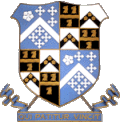The Latymer School
 |
|
| Motto | Qui Patitur Vincit [English: He who endures wins] |
|---|---|
| Established | 1624 |
| Type | Voluntary aided grammar school |
| Headteacher | Maureen Cobbett |
| Chairman of the Governing Body | ... |
| Founder | Edward Latymer |
| Location |
Haselbury Road Edmonton Greater London N9 9TN England Coordinates: 51°37′30″N 0°04′28″W / 51.6250°N 0.0744°W |
| Local authority | Enfield |
| DfE number | 308/5400 |
| DfE URN | 102055 Tables |
| Ofsted | Reports |
| Staff | 137 (as of Nov 2014) |
| Students | around 1,396 pupils |
| Gender | Coeducational |
| Ages | 11–18 |
| Houses | Ashworth Dolbé Keats Lamb Latymer Wyatt |
| Colours | Blue |
| Publication | Clio(School History Magazine) |
| Website | www |
The Latymer School is a selective, mixed grammar school in Edmonton, London, England, established in 1624 by Edward Latymer. According to league tables, Latymer is one of the top state-schools in the country. Its headteacher is Maureen Cobbett.
Latymer was established in 1624 on Church Street, Edmonton by bequest of Edward Latymer, a London City merchant in Hammersmith. Although most of his wealth passed to the people of Hammersmith and the Parish of St Dunstan's (now Latymer Upper School), he named certain properties and estates to fund the education and livelihoods of "eight poore boies of Edmonton" with a doublet, a pair of breeches, a shirt, a pair of woolen stockings and shoes distributed biannually on Ascension Day and All Saints' Day. Pupils were educated in "God's true religion" and reading English to the age of thirteen at existing petty schools. The boys had to wear the red Latymer cross on their sleeves and were under a duty to carry out the provisions of his will "unto the end of the world".
The school has formal links with St John's College, Cambridge (Edward Latymer's College) and Corpus Christi College, Cambridge (the College of Edward Latymer's father, William Latymer) which have endowments which may be used for the furtherance of the studies of former Latymer pupils at those colleges.
In 1662, John Wild of Edmonton made a bequest, including £4 per annum for the maintenance of a schoolmaster and a similar sum to maintain a poor scholar at Cambridge. This was followed in 1679 with Thomas Style's request of Edmonton of £20 per annum for teaching "twenty poor boys ... Grammar and Latin tongue." Several similar benefactions produced about £550 per annum, which funded the instruction of more than one hundred boys, of which sixty were clothed. For more than a century, no further significant bequests were made until in 1811, Ann Wyatt, an eccentric widow from Hackney, left £500 5% Navy Annuities to build a new school, and £100 in the same securities for its maintenance. The school-room was built in 1811 in accordance to her will.
...
Wikipedia
